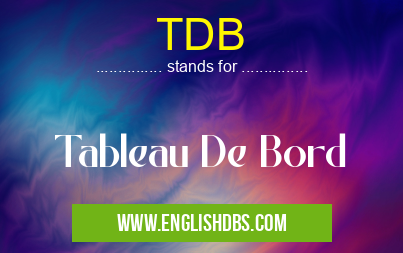What does TDB mean in FRENCH
TDB is an acronym that stands for Tableau De Bord. It is a French term that translates to "dashboard" in English. A dashboard is a tool that provides a comprehensive overview of key performance indicators (KPIs) and other relevant data in a single, visual interface. It is designed to help businesses track their progress towards goals, identify areas for improvement, and make informed decisions.

TDB meaning in French in International
TDB mostly used in an acronym French in Category International that means Tableau De Bord
Shorthand: TDB,
Full Form: Tableau De Bord
For more information of "Tableau De Bord", see the section below.
» International » French
TDB Meaning in INTERNATIONAL
The term TDB is commonly used in the international business community, particularly in the context of performance management and data analytics. It is used to refer to a dashboard that provides a visual representation of key metrics and insights, enabling users to monitor and control their business operations.
TDB Full Form
TDB stands for:
- T: Tableau
- D: De
- B: Bord
What Does TDB Stand For?
TDB stands for Tableau De Bord, which means "dashboard" in English. It is a tool used to visualize and monitor key performance indicators (KPIs) and other relevant data.
Benefits of Using TDB
- Real-time Data Visualization: Provides real-time access to data and displays it in an easy-to-understand visual format.
- Performance Monitoring: Tracks progress towards goals and identifies areas for improvement.
- Decision Support: Provides insights and data-driven recommendations to support decision-making.
- Collaboration and Communication: Facilitates collaboration and communication among team members by providing a shared view of performance data.
- Customization: Can be customized to meet specific business needs and requirements.
Essential Questions and Answers on Tableau De Bord in "INTERNATIONAL»FRENCH"
What is a Tableau De Bord (TDB)?
A Tableau De Bord (TDB) is a visual representation of data that provides a comprehensive overview of key performance indicators (KPIs) and metrics. It helps organizations monitor and track progress towards strategic objectives, allowing for informed decision-making.
What are the key components of a TDB?
A TDB typically consists of a dashboard, which displays the KPIs and metrics graphically, and a set of underlying data sources. The dashboard presents the data in an easy-to-understand format, often using charts, graphs, and tables.
What are the benefits of using a TDB?
TDBs offer several benefits, including:
- Real-time insights: TDBs provide up-to-date data, enabling organizations to track progress and identify areas for improvement in real-time.
- Improved decision-making: By providing a clear view of key metrics, TDBs empower decision-makers to make informed decisions based on data rather than intuition.
- Increased transparency: TDBs create transparency within organizations, ensuring that all stakeholders have access to the same information.
How do you create a TDB? A: Creating a TDB typically involves the following steps: Identify KPIs: Determine the key performance indicators that are most relevant to the organization's strategic objectives. Collect dat
Creating a TDB typically involves the following steps:
- Identify KPIs: Determine the key performance indicators that are most relevant to the organization's strategic objectives.
- Collect data: Gather data from various sources to support the chosen KPIs.
- Design the dashboard: Create a visually appealing and easy-to-understand dashboard using software tools.
- Monitor and update: Regularly monitor the TDB and make updates as needed to keep the data current and relevant.
What are some best practices for using a TDB?
To maximize the effectiveness of a TDB, follow these best practices:
- Keep it simple: Avoid cluttering the dashboard with too much information. Focus on displaying the most important metrics.
- Use visual cues: Leverage charts, graphs, and colors to make the data easy to understand and identify trends.
- Ensure data accuracy: Verify the accuracy and reliability of the data sources to ensure that the TDB provides accurate insights.
Final Words: TDB is a valuable tool for businesses of all sizes, as it provides a comprehensive and visual representation of key performance indicators. By leveraging TDBs, businesses can gain insights, make informed decisions, and improve their overall performance.
TDB also stands for: |
|
| All stands for TDB |
